|
Click on images for high-resolution jpeg images. When using these images, please credit Fermilab.
Return to Press Release
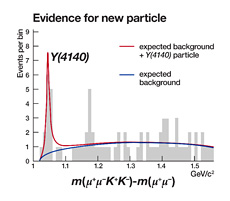 The CDF collaboration found evidence for a new particle dubbed
Y(4140), produced by the Tevatron collider at Fermilab. The
particle's signature peak became apparent when scientists analyzed the
decay of particles that produce pairs of muons and pairs of K mesons,
revealing a new particle structure. The Y particle has a mass of 4140
Mega-electron volts.
The CDF collaboration found evidence for a new particle dubbed
Y(4140), produced by the Tevatron collider at Fermilab. The
particle's signature peak became apparent when scientists analyzed the
decay of particles that produce pairs of muons and pairs of K mesons,
revealing a new particle structure. The Y particle has a mass of 4140
Mega-electron volts.
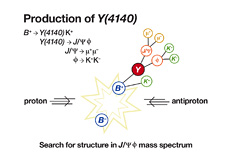 The Tevatron typically produces about 10 million proton-antiproton collisions per second, sometimes creating particles known as B mesons. A B meson contains a quark-antiquark pair that includes either a bottom quark or anti-bottom quark. B mesons can decay directly into a J/Ψ (psi) particle and a Φ (phi) particle. The CDF scientists found evidence that some B mesons unexpectedly decay into an intermediate quark structure identified as a Y particle.
The Tevatron typically produces about 10 million proton-antiproton collisions per second, sometimes creating particles known as B mesons. A B meson contains a quark-antiquark pair that includes either a bottom quark or anti-bottom quark. B mesons can decay directly into a J/Ψ (psi) particle and a Φ (phi) particle. The CDF scientists found evidence that some B mesons unexpectedly decay into an intermediate quark structure identified as a Y particle.
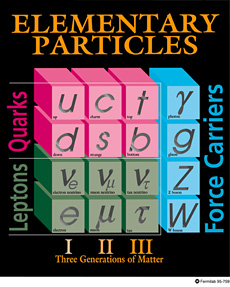 The Standard Model of elementary particles and forces includes six quarks, which bound together to form composite particles. Physicists have an excellent understanding of how three quarks cluster together to form protons, neutrons and heavier baryons, and how a quark and anti-quark bind together to create pions, kaons and other mesons. But electron-positron colliders at SLAC National Accelerator Laboratory and the Japanese laboratory KEK have revealed examples of composite quark structures--named X and Y particles--that are not the usual mesons and baryons. Now the CDF collaboration at Fermilab has found evidence for the Y(4140) particle.
The Standard Model of elementary particles and forces includes six quarks, which bound together to form composite particles. Physicists have an excellent understanding of how three quarks cluster together to form protons, neutrons and heavier baryons, and how a quark and anti-quark bind together to create pions, kaons and other mesons. But electron-positron colliders at SLAC National Accelerator Laboratory and the Japanese laboratory KEK have revealed examples of composite quark structures--named X and Y particles--that are not the usual mesons and baryons. Now the CDF collaboration at Fermilab has found evidence for the Y(4140) particle.
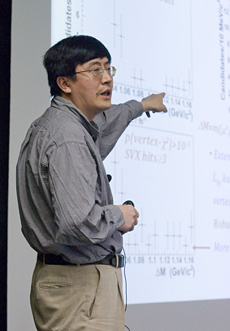 CDF physicist Kai Yi, University of Iowa, unveiled the evidence of the Y(4140) particle to scientists at Fermilab at seminar on March 17, 2009.
CDF physicist Kai Yi, University of Iowa, unveiled the evidence of the Y(4140) particle to scientists at Fermilab at seminar on March 17, 2009.
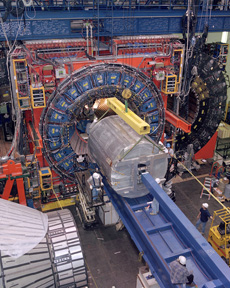 The CDF detector, about the size of a 3-story house, weighs about 6,000 tons. Its subsystems record the "debris" emerging from high-energy proton-antiproton collisions. The detector surrounds the collision point and records the path, energy and charge of the particles emerging from the collisions. This information can be used to determine, for example, the find new particles such as the Y(4140).
The CDF detector, about the size of a 3-story house, weighs about 6,000 tons. Its subsystems record the "debris" emerging from high-energy proton-antiproton collisions. The detector surrounds the collision point and records the path, energy and charge of the particles emerging from the collisions. This information can be used to determine, for example, the find new particles such as the Y(4140).
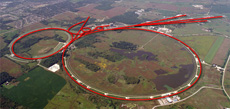 The Fermilab accelerator complex accelerates protons and antiprotons close to the speed of light. Two experiments, CDF and DZero, record the particles emerging from millions of collisions per second produced by the Tevatron collider. Each collision produces hundreds of particles.
The Fermilab accelerator complex accelerates protons and antiprotons close to the speed of light. Two experiments, CDF and DZero, record the particles emerging from millions of collisions per second produced by the Tevatron collider. Each collision produces hundreds of particles.
For additional photos and B roll video footage, including video clips of the Tevatron collider experiments and aerials of the Fermilab site, visit the Fermilab Visual Media Services website. To obtain permission for the use of this additional material, please send an email to vismedsr@fnal.gov.
Return to Press Release
|








